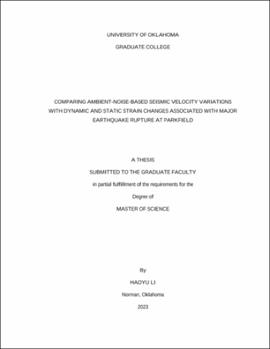| dc.description.abstract | Stress perturbations across a fault zone can change seismic wave velocity in the adjacent area, with implications for rock properties and fault mechanics. Ambient noise seismic interferometry is increasingly used to retrieve information about wave propagation between seismic stations, constrain seismic velocity changes, and potentially monitor the subsurface strain field. Comparing seismic velocity changes with strain changes in space and time may help us understand the damage and healing processes of fault rocks. Here we study the seismic velocity and strain changes in the shallow crust associated with the 2004 Mw 6.0 Parkfield earthquake in California. We process continuous seismic recordings from 13 stations of the High Resolution Seismic Network (HRSN) from 2001 to 2007. Then we use an open-source software NoisePy (Jiang and Denolle, 2020) to cut band-pass-filtered data into 1-hour chunks and perform cross-correlation, stack hourly cross-correlation functions into 30-day averages, and retrieve reference Green’s functions based on a criteria of cross-correlation coefficients. To estimate the history of relative velocity changes, dv/v, we use a moving-window cross spectrum method with a moving window of 30 days. To resolve potential spatial variations in velocity changes, we first fit the dv/v history with a parametric function with seasonal, offset, and logarithmic terms, then select better-fitting station pairs based on signal-to-residual ratios and map the coseismic velocity changes at 5 frequency bands. We also assess the relationship between dv/v estimates, peak dynamic strains from strong-motion seismograms, and static strain changes inferred from coseismic and postseismic space-geodetic measurements. Our results show larger amplitudes of coseismic velocity drops in higher frequency bands for both network-averaged and station-pair dv/v values. We attribute the instantaneous drop of dv/v to ground shaking during the earthquake and the later gradual increase of dv/v to the postseismic recovery of shallow fault zones. While the coseismic dv/v changes suggest potential spatial variations across the fault, future efforts are needed to quantify and reduce uncertainties. Our study will help improve strategies to obtain robust dv/v time series and distinguish the causes of seismic velocity changes in the subsurface. | en_US |
